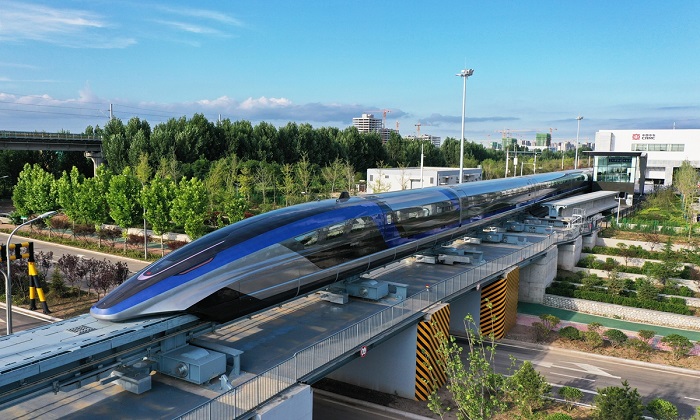ISABEL RUBIO ARROYO | Tungsteno
While the Maglev reaches 600 kilometres per hour, the CR400 'Fuxing' can run at up to 420 kilometres per hour. These are some of the fastest trains on the planet. Faced with the unstoppable growth in demand for transport, the aim is for trains to become a cleaner and more efficient alternative to planes and cars. We take a look at the technologies enabling trains to reach record speeds.
Magnetic levitation will be the fastest
The Maglev is currently the fastest available ground vehicle within the range of 1,500 kilometres, according to a report by Chinese manufacturer CRRC reported by Global Times. This magnetic levitation train, which made its debut in China's Qingdao province, reaches 600 kilometres per hour. It can therefore fill the gap between current high-speed trains, which runs at around 350 km/h, and airplanes, with a speed of around 800 km/h. At 600 km/h, it would take only two and a half hours to travel from Beijing to Shanghai by train, a journey of more than 1,000 km. By comparison, the trip would take three hours by plane and more than five hours by high-speed rail.
The Maglev uses electromagnetic force to travel, which means it 'levitates' above the track without contact between the body and the rail. It also incorporates a system that allows it to reduce the braking distance to about 10 kilometres, so it can run for longer at a higher speed. Ding Sansan, chief engineer of the project, explains that this train can travel with two to 10 carriages, each with a capacity of more than 100 passengers.
Other countries such as Japan and Germany are also looking to build magnetic levitation networks. While these trains have advantages in terms of efficiency, speed and noise pollution, they also have some drawbacks. In addition to the high costs of constructing these networks, they are incompatible with the current track infrastructure. Zhao Jian, a professor at Beijing Jiaotong University, considers it unlikely that China will export its magnetic levitation train and relevant technologies in the near future, as other countries lack the scale to make magnetic levitation lines profitable. "The maglev lines can earn money only when a network of high-speed transportation is formed, with huge passenger flows," he says.
The Maglev uses electromagnetic force to move, so it 'levitates' above the track with no contact between body and rail. Credit: Touch Shandong
Trains that survive in extreme conditions
Beyond magnetic levitation systems, there are also some regular trains that are especially fast. China's CR400 "Fuxing" trains travel at around 350 km/h, although in some tests they have reached 420 km/h. With up to 17 carriages, these bullet trains have a capacity of 1,280 passengers. In 2020, China unveiled a new 174-kilometre high-speed rail line connecting Beijing with the 2022 Winter Olympics host city of Zhangjiakou, cutting travel time from nearly three hours to just 47 minutes. According to China State Railway Group, more than 1,000 Fuxing bullet trains have been put into operation since 2017.
One of the challenges for manufacturers is to adapt bullet trains to extreme conditions. The CR400AF-G, which is part of the Fuxing series of high-speed electric trains, has been designed to operate in extremely cold climates. Its components include bolts made of materials that can withstand extremely low temperatures, silicone sealing strips that prevent snow and ice from entering the train body, and stainless steel pipes equipped with heating devices.
Zhou Song, director of the bullet train centre of the China Railway Beijing Group, gives an analogy in the China Daily newspaper to explain the braking system of the new train: "If the train stops in Harbin (one of China's coldest cities) for an hour, because of the extremely cold weather, the braking system could easily freeze up if it stops moving for a while. The new system will enable the brakes to move from time to time even if the train stops, like a person stamping his feet to keep warm in cold weather."
Manufacturers are looking for ways to adapt bullet trains to extreme conditions. Credit: New China TV
Efficient transport to reduce environmental footprint
Among the fastest trains on the planet, there are also others like the ICE3, known as the "White Worm". Manufactured by Germany's InterCity Express (ICE) company, it is capable of reaching 330 kilometres per hour. France is another country that has significantly improved these trains since the Second World War. The TGV, one of the fastest conventional trains in the world, operates at speeds of up to 320 km/h on some sections. These trains run from north to south and east to west across France, reaching as far as Marseille, Lille, Calais, Paris and Strasbourg. Despite these achievements, high-speed trains face some challenges, such as air resistance, which increases exponentially with speed, and pressure variations in tunnels of different lengths.
The aim is for trains to become a cleaner and more efficient alternative to planes and cars. Credit: Unsplash
The International Energy Agency (IEA) expects passenger and freight activity to double by 2050. As global demand for transport grows, ultra-fast trains aim to gain traction in the coming years. Greater reliance on these machines has the potential to reduce emissions of carbon dioxide and other air pollutants. "High-speed rail can serve as an alternative to short-distance air travel, and conventional and freight rail can complement other transport modes to provide efficient mobility," the IEA says.
· — —
Tungsteno is a journalism laboratory to scan the essence of innovation. Devised by Materia Publicaciones CientÃficas for Sacyr’s blog.
